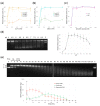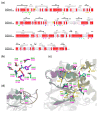Actin-Resistant DNase1L2 as a Potential Therapeutics for CF Lung Disease
- PMID: 33802146
- PMCID: PMC8002113
- DOI: 10.3390/biom11030410
Actin-Resistant DNase1L2 as a Potential Therapeutics for CF Lung Disease
Abstract
In cystic fibrosis (CF), the accumulation of viscous lung secretions rich in DNA and actin is a major cause of chronic inflammation and recurrent infections leading to airway obstruction. Mucolytic therapy based on recombinant human DNase1 reduces CF mucus viscosity and promotes airway clearance. However, the marked susceptibility to actin inhibition of this enzyme prompts the research of alternative treatments that could overcome this limitation. Within the human DNase repertoire, DNase1L2 is ideally suited for this purpose because it exhibits metal-dependent endonuclease activity on plasmid DNA in a broad range of pH with acidic optimum and is minimally inhibited by actin. When tested on CF artificial mucus enriched with actin, submicromolar concentrations of DNase1L2 reduces mucus viscosity by 50% in a few seconds. Inspection of superimposed model structures of DNase1 and DNase1L2 highlights differences at the actin-binding interface that justify the increased resistance of DNase1L2 toward actin inhibition. Furthermore, a PEGylated form of the enzyme with preserved enzymatic activity was obtained, showing interesting results in terms of activity. This work represents an effort toward the exploitation of natural DNase variants as promising alternatives to DNase1 for the treatment of CF lung disease.
Keywords: PEGylation; Pichia pastoris; cystic fibrosis; endonuclease; enzyme therapeutics; mucolytics.
Conflict of interest statement
The authors declare no conflict of interest. The funders had no role in the design of the study; in the collection, analyses, or interpretation of data; in the writing of the manuscript, or in the decision to publish the results.
Figures






Similar articles
-
Impact of PEGylation on the mucolytic activity of recombinant human deoxyribonuclease I in cystic fibrosis sputum.Clin Sci (Lond). 2018 Jul 18;132(13):1439-1452. doi: 10.1042/CS20180315. Print 2018 Jul 18. Clin Sci (Lond). 2018. PMID: 29871879
-
DNA and actin bind and inhibit interleukin-8 function in cystic fibrosis sputa: in vitro effects of mucolytics.Am J Respir Crit Care Med. 2000 Nov;162(5):1767-72. doi: 10.1164/ajrccm.162.5.9908107. Am J Respir Crit Care Med. 2000. PMID: 11069810
-
Anionic poly(amino acid)s dissolve F-actin and DNA bundles, enhance DNase activity, and reduce the viscosity of cystic fibrosis sputum.Am J Physiol Lung Cell Mol Physiol. 2005 Oct;289(4):L599-605. doi: 10.1152/ajplung.00061.2005. Epub 2005 Jun 17. Am J Physiol Lung Cell Mol Physiol. 2005. PMID: 15964901
-
Mucolytics in cystic fibrosis.Paediatr Respir Rev. 2007 Mar;8(1):24-9. doi: 10.1016/j.prrv.2007.02.009. Epub 2007 Mar 21. Paediatr Respir Rev. 2007. PMID: 17419975 Review.
-
Unplugging Mucus in Cystic Fibrosis and Chronic Obstructive Pulmonary Disease.Ann Am Thorac Soc. 2016 Apr;13 Suppl 2:S177-85. doi: 10.1513/AnnalsATS.201509-641KV. Ann Am Thorac Soc. 2016. PMID: 27115954 Review.
Cited by
-
Pathological Significance of Macrophages in Erectile Dysfunction Including Peyronie's Disease.Biomedicines. 2021 Nov 10;9(11):1658. doi: 10.3390/biomedicines9111658. Biomedicines. 2021. PMID: 34829887 Free PMC article. Review.
-
RNA-Seq of Chicken Embryo Liver Reveals Transcriptional Pathways Influenced by Egg Formaldehyde Treatment.Genes (Basel). 2025 Apr 22;16(5):471. doi: 10.3390/genes16050471. Genes (Basel). 2025. PMID: 40428293 Free PMC article.
-
Systemic mechanisms of necrotic cell debris clearance.Cell Death Dis. 2024 Aug 1;15(8):557. doi: 10.1038/s41419-024-06947-5. Cell Death Dis. 2024. PMID: 39090111 Free PMC article. Review.
-
Different results despite high homology: Comparative expression of human and murine DNase1 in Pichia pastoris.PLoS One. 2025 Apr 29;20(4):e0321094. doi: 10.1371/journal.pone.0321094. eCollection 2025. PLoS One. 2025. PMID: 40299953 Free PMC article.
-
Application of biofilm dispersion-based nanoparticles in cutting off reinfection.Appl Microbiol Biotechnol. 2024 Jun 19;108(1):386. doi: 10.1007/s00253-024-13120-7. Appl Microbiol Biotechnol. 2024. PMID: 38896257 Free PMC article. Review.
References
-
- Lethem M.I., James S.L., Marriott C., Burke J.F. The origin of DNA associated with mucus glycoproteins in cystic fibrosis sputum. Eur. Respir. J. 1990;3:19–23. - PubMed
Publication types
MeSH terms
Substances
Grants and funding
LinkOut - more resources
Full Text Sources
Other Literature Sources
Medical

